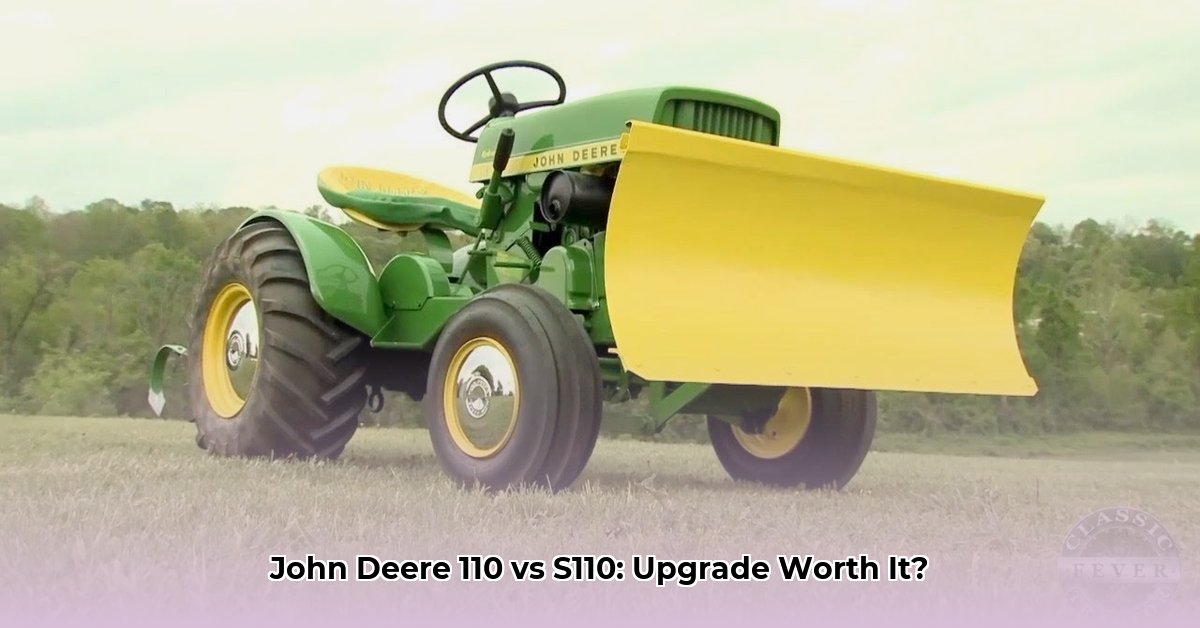
Design and Features: A Generation Apart
The John Deere 110 and S110 represent distinct eras in garden tractor design. The 110, a stalwart of the 1960s and 70s, embodies classic simplicity. Its 7-8 horsepower engine (a small gasoline engine) and manual transmission provided reliable, if somewhat basic, performance for smaller properties. This tractor is known for its robust build and relative ease of maintenance for mechanically inclined users. However, its age shows in features like the spartan bench seat and less intuitive controls. For more options, check out these used tractors.
Conversely, the S110 showcases modern advancements. Its 19-horsepower engine (a more powerful gasoline engine) provides significantly more power, making it suitable for larger properties and more demanding tasks. The hydrostatic transmission (an automatic transmission system) offers infinitely variable speeds, enhancing maneuverability and reducing operator fatigue. The S110 also boasts a more comfortable, ergonomically designed seat, improving the overall user experience.
Here's a side-by-side comparison:
| Feature | John Deere 110 | John Deere S110 |
|---|---|---|
| Engine Horsepower | 7-8 hp | 19 hp |
| Transmission | Manual Gear Shift | Hydrostatic (Infinitely Variable) |
| Cutting Deck | Optional, Narrower Cutting Width | Optional, Wider Cutting Width |
| Seat Comfort | Basic Bench Seat | More Supportive, Ergonomic Design |
| Maintenance | More Involved, Requires More Tools | Easier Access to Key Components |
| Maneuverability | Somewhat Difficult in Tight Spaces | Excellent Maneuverability |
Performance: Power and Efficiency Compared
The S110's superior horsepower is immediately apparent. It tackles heavier workloads with ease, mowing larger areas faster. But horsepower isn't the only factor influencing performance. The hydrostatic transmission provides smoother operation and better control, particularly on uneven terrain. This translates to greater efficiency and reduced operator effort. While precise fuel consumption data for direct comparison is unavailable, the S110's more powerful yet potentially more efficient engine and transmission suggest better fuel economy per acre mowed, especially on larger or more challenging landscapes. Isn’t fuel efficiency a crucial consideration for sustainable practices?
Maintenance and Durability: A Legacy of Reliability, Reimagined
Both tractors are known for their durability, reflecting John Deere's commitment to quality. However, the S110 demonstrates a focus on easier maintenance. Key components are more accessible, streamlining routine servicing and reducing downtime. This translates to lower long-term maintenance costs and a longer operational lifespan, contributing further to its sustainability advantages.
Sustainability: Environmentally Conscious Choices
The S110’s advantages extend beyond mere performance. Its improved fuel efficiency directly reduces greenhouse gas emissions, aligning with sustainable agricultural practices. This, coupled with the reduced operator fatigue due to its superior ergonomics and intuitive controls, makes the S110 a more environmentally and economically responsible choice for prolonged use.
Cost and Value: Weighing the Investment
The S110 carries a higher initial purchase price than the 110. However, this increased cost is offset by its superior performance, fuel efficiency, reduced maintenance, and longer lifespan. The enhanced operator comfort also contributes to increased productivity and reduced fatigue-related downtime. Does the long-term value proposition of the S110 outweigh the higher initial investment? It depends on your needs and the scale of your operations.
Conclusion: Which Tractor Suits Your Needs?
The John Deere 110 remains a reliable option for those with smaller properties, simpler landscaping needs, and a preference for a more hands-on, classic machine. Its lower initial cost makes it an attractive entry-level choice. However, for larger properties, more demanding tasks, and a higher emphasis on efficiency, comfort, and sustainability, the S110 offers a compelling upgrade. Its more powerful engine, ergonomic design, and improved fuel efficiency contribute to significant long-term benefits. Ultimately, the choice depends on individual circumstances and priorities. Choosing the right tractor is all about aligning functionality with your practical needs and long-term goals.